Woodyard D. (ed.) Pounders Marine diesel engines and Gas Turbines
Подождите немного. Документ загружается.

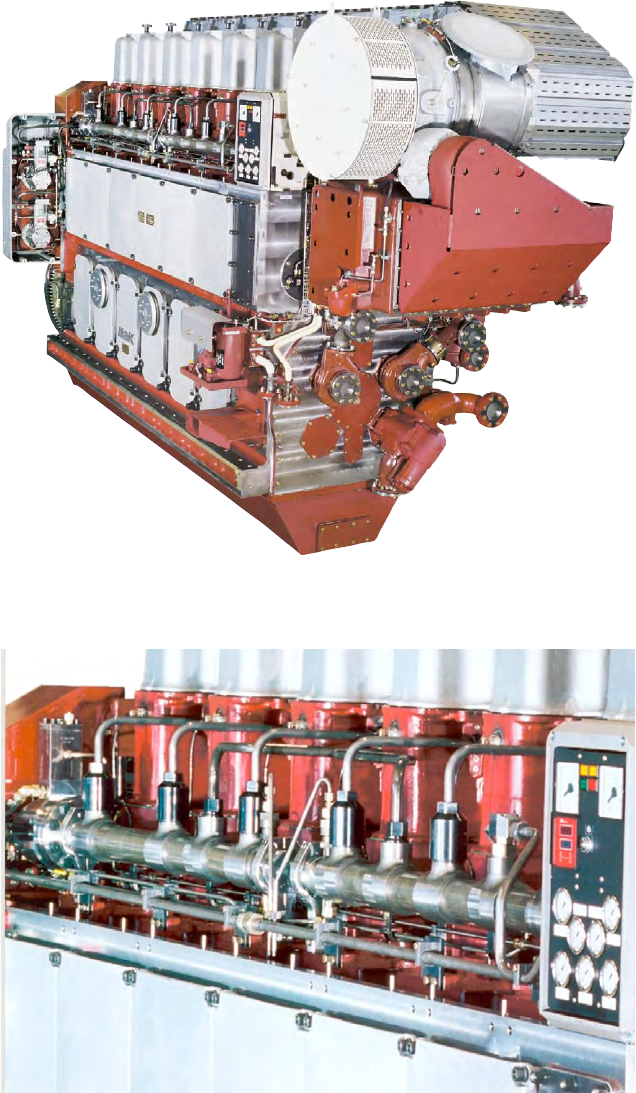
566 MaK (Caterpillar Marine Power Systems)
Figure 21.12 The Caterpillar common rail (CCr) fuel injection system made its
debut on a six-cylinder MaK M32C propulsion engine
Figure 21.13 A CCr system rail segment and injectors
Caterpillar highlights these merits of CCR technology: high fuel-injection
pressure over the entire engine operating range; fully flexible fuel injection fos-
tering optimized emissions and engine performance; and suitability for engines
operating on HFO or marine diesel oil. A CCR system incorporates the follow-
ing main elements:
High-pressure pumps: Two sets deliver the required amount of fuel to the
rail and provide the desired rail pressure in closed-loop control. The pumps are
based on a proven design but with modifications for heavy fuel operation. A
two-pump configuration for all in-line cylinder engines significantly reduces
the amount of high-pressure connections and components while securing
redundancy; and suction control ensures high pump efficiency (Figure 21.14).
Rail: The double-walled rails are pressurized and serve as an accumula-
tor. One rail segment feeds fuel to several injectors; for example, a nine-cyl-
inder engine has three rail segments, each feeding three injectors, while an
eight-cylinder engine has two rail segments, each feeding four injectors. Such
an arrangement reduces the overall number of parts and high-pressure con-
tacts required. Flow limiters prevent the cylinder from over-fuelling; and a
safety valve acts as pressure relief in the event of an over-pressurized rail. A
scavenging circuit enables the complete fuel system (high and low pressure)
to be maintained in a preheated condition, which is essential for safe HFO
operation.
Injectors: A simple, robust and compact approach was pursued by using
the fuel itself to control the injector, thereby eliminating the need for a sep-
arate control fluid. The injector nozzle is cooled with lube oil, a typical fea-
ture for HFO operation. For the CCR system, however, the lube oil circuit was
extended to provide cooling as well to the electrical components within the
injector, thus increasing their lifetime. The injection process is electronically
controlled, facilitating flexible injection timing and duration, including the
capability for multi-shots. Injection pattern and shaping was optimized using
the combustion modelling offered by Caterpillar’s own 3D software as well as
by comprehensive engine testing.
Injection mapping enables injection characteristics to be fine-tuned for
every single engine operating point, reportedly guaranteeing optimum injec-
tion pressure and timing at a given load even in transient operation. Both soot
and NOx emissions are thereby significantly reduced. There is also the poten-
tial through injection mapping to balance the overall wear of an ageing engine
using modified control parameters implemented during regular servicing.
Electronics: Caterpillar’s proprietary ADEM Electronic Control Module
(ECM) manages fuel delivery, air supply and other fundamental engine proc-
esses to achieve an optimum balance of performance and emissions. The soft-
ware was tailor-made for CCR-equipped MaK engines, addressing the specific
demands of HFO operation. The ECM functions can be divided into a core
system and a performance system, the former comprising: an A4E4 control
device; a crankshaft speed pick-up; two camshaft speed pick-ups; two high-
pressure sensors; two suction throttles; and injectors.
Common rail fuel system 567
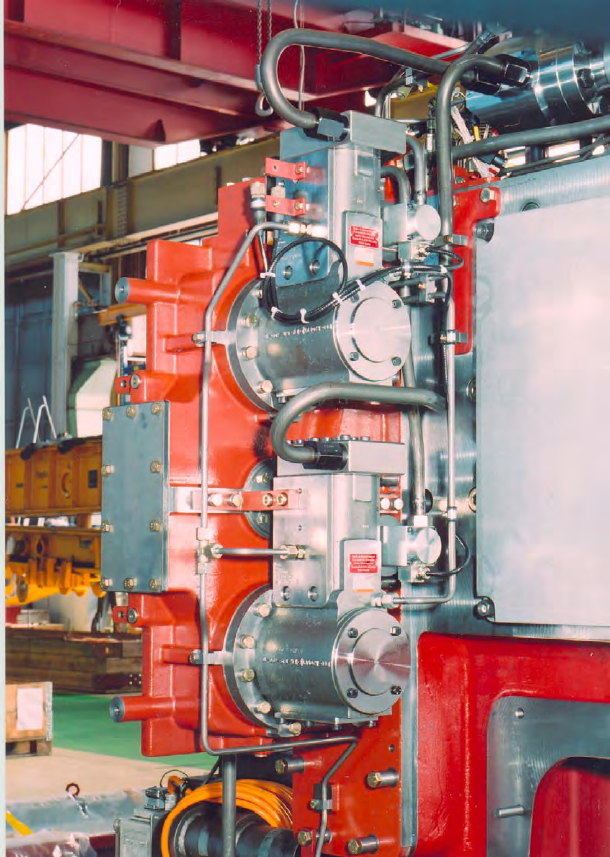
568 MaK (Caterpillar Marine Power Systems)
Optimum engine settings under all operating conditions are sought by
the performance system, using such information as exhaust gas temperature,
charge air pressure, ambient conditions and lube oil temperature. The engine
protection system works independently of the engine control system and has
its own sensor equipment, ensuring that engine operation is monitored inde-
pendently of other control systems.
Figure 21.14 Two high-pressure pumps deliver fuel to the common rail of the CCr
system
expert System Support
MaK offers intelligent expert systems to lower operational costs, minimize
downtime and increase availability. DICARE is a Windows-based expert sys-
tem providing real-time engine diagnosis. It describes and diagnoses the actual
engine condition and provides references for condition-based maintenance.
Remote data transfer to a ship owner’s shore base is facilitated by a commu-
nication module; additionally, MaK offers a link to its service department for
evaluating and interpreting the data.
DICARE was launched in 1987 on an MS DOS platform. A 16-bit MS
Windows version in 1997 eventually led to the latest 32-bit variant. Data was
initially received from the alarm system but today the engine’s existing control
bus system is leveraged. Measured values are displayed on engine schematics
and gauges, with automatic data recording facilitating black box functions.
DIMOS is a computer-based maintenance and service system covering
MaK engines. It delivers service interval supervision and immediate access to
maintenance and component information via an electronic operations hand-
book. Bus technology underwrites safe digital signal transmission and repre-
sents a clearly defined connecting point for all ship management systems.
eArLier MAK MOdeLS
Numerous examples of earlier MaK medium-speed designs are in service in
propulsion and auxiliary power installations based on 240 mm bore M282C/
M332C, 320 mm bore M453C, 450 mm bore M552C and 580 mm bore M601C
engines. The ‘C’ designation models were introduced in the 1980s with refine-
ments enhancing the capability to operate on heavy fuel (Figure 21.8).
The robust engines feature housings of high-duty cast iron which, in the
case of the 320 mm bore and larger models, take the form of multi-sectional
blocks connected by steel tension rods. The high pre-stressing of the rods,
which keep the cast components under compression stress, prevents any tensile
stress in the cast material, even under ignition loads. The 240 mm bore series
features an underslung crankshaft.
The cylinder liners of all the engines are salt bath nitrated for high wear
resistance and anti-corrosion properties; crankshafts are forged in one piece
from wear-resistant, quenched and tempered alloy steel. Single fuel injection
pumps are used throughout the series, the injection system and inlet/exhaust
valves being controlled by a one-part camshaft.
earlier MaK models 569
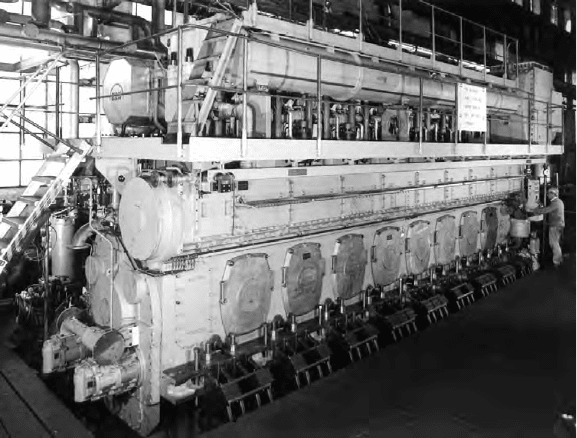
571
C h a p t e r | t w e n t y t w o
Man Diesel
A long tradition in medium-speed engine design was exploited by MAN Diesel
to create a new generation of 400 mm, 480 mm and 580 mm bore models sharing
common principles. The 40/54, 48/60 and 58/64 series (Figures 22.1 and 22.2),
progressively launched during the 1980s, were joined in 1992 by the 32/40 design
which inherited similar features but modified to suit its smaller bore. The four
engines have since formed the core of the Augsburg, Germany-based group’s
programme offering outputs from 2880 kW to 21 600 kW (see Table 22.1), with
progressive refinements enhancing power ratings, fuel economy and emissions
performance. Common rail (CR) fuel injection benefits the latest CR versions.
L58/64 engine
The ‘new generation’ programme was headed in 1984 by the 580 mm bore/
640 mm stroke L58/64 series, whose designers sought a high overall operating
Figure 22.1 an eight-cylinder version of Man Diesel’s largest medium-speed
engine design, the L58/64

572 Man Diesel
economy, reliability, ease of maintenance, component durability and unre-
stricted heavy fuel compatibility. The rugged (Figure 22.3) result can be
contrasted with MAN Diesel’s previous large bore engine, the 520 mm bore
52/55B (Figure 22.4).
Among the main features of the L58/64 and its 400 mm and 480 mm bore
derivatives is a stiff monobloc frame casting with continuous tie-rods from
the underslung main bearings to the top edge of the engine frame, and tie-
rods from the cylinder head to the frame diaphragm plate (Figures 22.5 and
22.6). This arrangement was associated with the following: an optimum flow
of forces from the cylinder head down to the crankshaft; minimal deformation
of the cylinder liner; more reliable piston performance; all parts of the frame
under pre-stress; cross-braced crankshaft bearings; an amply dimensioned out-
board bearing for absorbing high radial forces at the power take-off end of the
Figure 22.2 Cross-sections of original ‘new generation’ family (left to right L58/64,
L48/60, L40/54)
Table 22.1 Man’s original ‘new generation’ medium-speed engine line-up
Parameter Model
32/40 40/54 48/60B 58/64
Bore (mm) 320 400 480 580
Stroke (mm) 400 540 600 640
Cylinders 5–9L/12–18V 6–9L 6–9L/12–18V 6–9L
Output (kW/cyl) 480 720 1200 1390
Speed (rev/min) 720/750 550 514 428
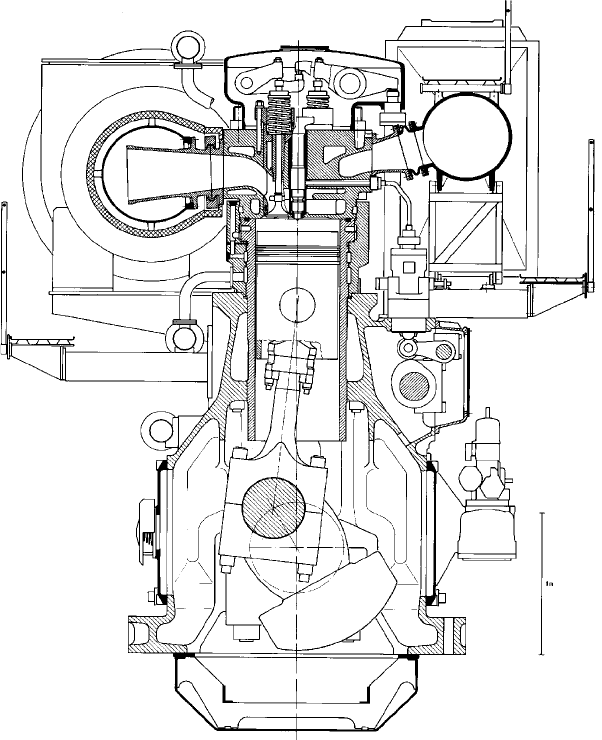
crankshaft; no cooling water passage in the casing (eliminating the potential
for corrosion); sturdy landings to prevent plant deformation; and camshaft
drive gear and vibration damper integrated in the engine casing.
Minimal deformation of the liner, reliable piston performance, no deforma-
tion of the neighbouring cylinder and reduced deformation over the full length
of the engine are further underwritten by individual cylinder jackets.
Cavitation of the cylinder liner (Figure 22.7) is prevented by thick walls
giving a high resistance to deformation, while virtually uniform temperatures
over the entire liner surface result from intensive cooling of just the upper part
of the liner (cooling is not considered necessary elsewhere), thanks to a special
arrangement of the cooling water spaces. Good lubricating conditions result
and low-temperature corrosion is inhibited.
L58/64 engine 573
Figure 22.3 Man L58/64 design
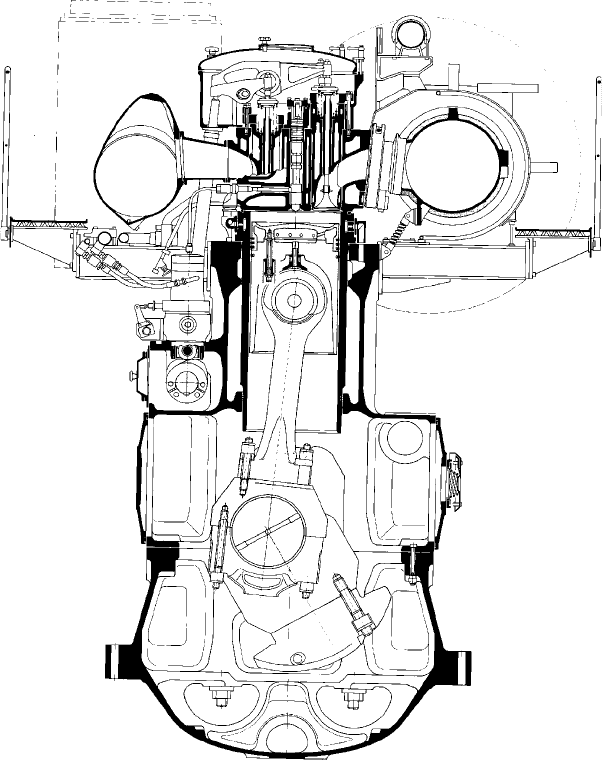
574 Man Diesel
A thin flame plate for the cylinder head promotes good heat conductivity
while high stiffness is imparted by a strong deck plate absorbing the vertically
acting gas forces (Figures 22.8–22.10). A long valve life and clean, gas-tight
seats are promoted by: water-cooled exhaust valve cages which are withdraw-
able without removing the rocker arms; armoured exhaust valves with gas-
driven propeller rotators; and caged inlet valves rotated by a Rotocap device.
Pollution of operating media is avoided in the cylinder head by separate spaces
for lubricating oil, fuel and cooling water. A simple connection attaches the
exhaust manifold to the head.
A composite piston (Figure 22.11) is formed from a forged aluminium
skirt and a forged thin-walled crown of high-grade steel (the smaller bore
Figure 22.4 The L52/55B design preceded the ‘new generation’ range headed by
the L58/64 engine
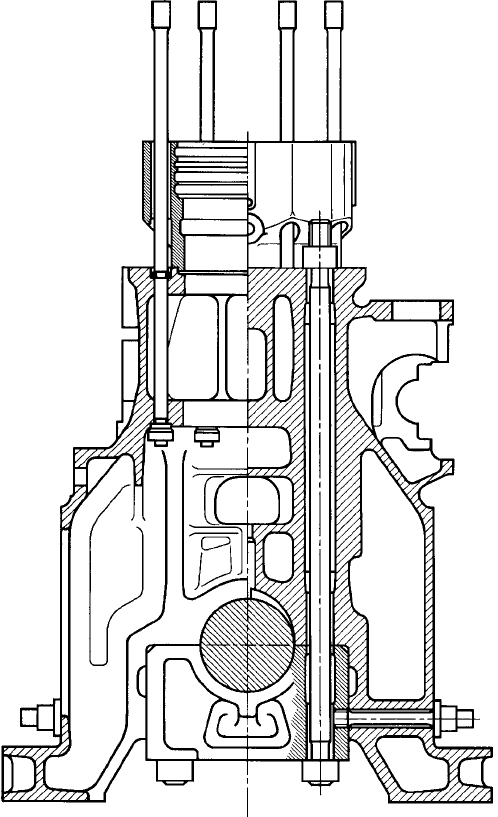
engines in the MAN programme feature a nodular cast iron skirt). Effective
cooling of the crown is sought from the cocktail shaker method (splash effect)
which nevertheless maintains temperatures in way of the ring grooves high
enough to prevent wet corrosion. Cooling oil flow arrangements are optimized
from inside to outside. A piston pin without cross-bore enhances component
reliability. A reduction of mechanical loads on the piston rings was addressed
by a narrow piston clearance, keeping out abrasive particles and protecting
the lubricating film. A long piston groove life was sought from induction
hardening, with the depth of hardening sufficient to allow re-machining sev-
eral times.
L58/64 engine 575
Figure 22.5 L58/64 engine frame
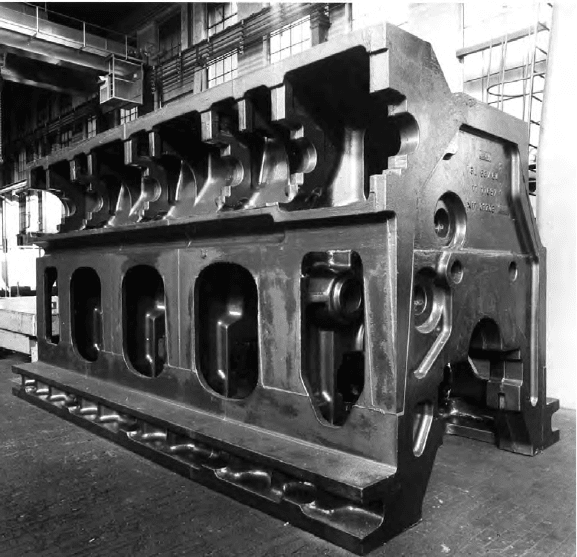
576 Man Diesel
All three compression rings are mounted in the crown, their durability
enhanced by plasma coating of the first ring and chrome plating of the sec-
ond and third rings. A consistently low lubricating oil consumption is reported
from the optimized ring set configuration.
The L58/64 engine was reportedly the first to feature a connecting rod with
a joint in the upper part of its shaft (Figure 22.12). A compact and very stiff
flange is permitted, and motion of the joint under mass forces (observed in tra-
ditional connecting rods) is not encountered. A merit is the very low overhead
space required for piston removal, with no need to open the crankpin bearing
when pulling the piston (Figure 22.13).
A fuel-optimized injection system with economy plunger is installed
(Figures 22.14–22.16). A modified control edge on the pump plunger keeps the
firing pressure virtually constant between 85 per cent and 100 per cent of max-
imum continuous rating, fostering favourable consumption rates throughout the
part-load range. A pressure-equalizing valve prevents the formation of partial
vacuums (and thus cavitation) as well as pressure fluctuations in the system
(and thus fuel dribbling). A high injection pressure yields efficient atomization
of the fuel, while an advantageous firing pressure/mean effective pressure ratio
Figure 22.6 Monobloc frame of L58/64 engine
